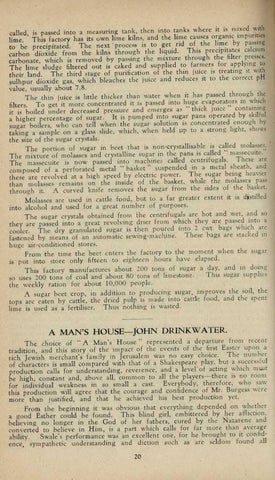called, is passed into a measuring tank, then into tanks where it is mixed with lime. This factory has its own lime kilns, and the lime causes organic impurities to be precipitated. The next 'process is to get rid of the lime by passing carbon dioiide from the kilns through the liquid. This precipitates calcium carbonate, which is removed by passing the mixture through the filter presses. The lime sludge filtered out is caked and supplied to farmers for applying to their land. The third stage of purification of the thin juice is treating it with sulhpur dioxide gas, which bleaches the juice and reduces it to the correct pH value, usually about 7.8. The .thin . juice is little thicker than water when it has passed through the filters. To get it more concentrated it is passed into huge evaporators in which it is boiled under decreased pressure and emerges as — thick juice " containing a higher percentage of sugar. It is pumped into sugar pans operated by skilful sugar boilers, who can tell when the sugar solution is concentrated enough by taking a sample on a glass slide, which, when held up to a strong light, shows the size of the sugar crystals. The portion of sugar in beet that is non-crystallisable is called molasses. The mixture of molasses and crystalline sugar in the pans is called " massecuite." The massecuite is now passed into machines called centrifugals. These are composed of a perforated metal " basket " suspended in a metal sheath, and these are revolved at a high speed by electric power. The sugar being heavier than molasses remains on the inside of the basket, while the molasses pass through it, A curved knife removes the sugar from the sides of the basket. Molasses are used in cattle food, but to a far greater extent it is distilled into alcohol and used for a great number of purposes. The sugar crystals obtained from the centrifugals are hot and wet, and so they are passed into a great revolving drier from which they are passed into a cooler. The dry granulated sugar is then poured into 2 cwt. bags which are fastened by means of an automatic sewing-machine. These bags are stacked in huge air-conditioned stores. From the time the beet enters the factory to the moment when the sugar is put into store only fifteen to eighteen hours have elapsed. This factory manufactures about 200 tons of sugar a day, and in doing so uses 200 tons of coal and about 80 tons of limestone. This sugar supplies the weekly ration for about 10,000 people. A sugar beet crop, in addition to producing sugar, improves the soil, the tops are eaten by cattle, the dried pulp is made into cattle food, and the spent lime is used as a fertiliser. Thus nothing is wasted. •
A MAN'S HOUSE
—
JOHN DRINKWATER.
•
The choice of " A' Man's House' represented a departure from recent tradition, and this story of the impact of the events of the first Easter upon a rich Jewish merchant's family in Jerusalem was no easy choice. The number of characters is small compared with that of a Shakespeare play, but a successful production calls for understanding, reverence, and a level' of acting which must be high, constant and, above all, common to all the players—there is no room for individual weakness in so small a cast. Everybody, therefore, who saw this production will agree that the courage and confidence of Mr. Burgess were more than justified, and that he achieved his best production yet. From the beginning it was obvious that everything depended on whether a good Esther could be found. This blind girl, embittered by her affliction, believing no longer in the God of her fathers, cured by the Nazarene and converted to believe in Him, is a part which calls for far more than average ability. Swale's performance was an excellent one, for he brought to it confidence, sympathetic understanding and diction such as are seldom found all 20
.




